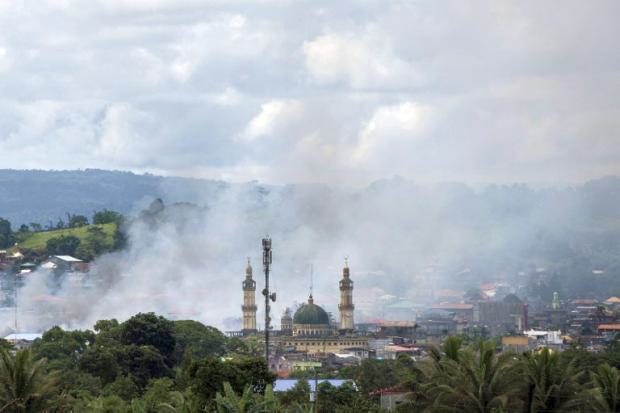WesMinCom chief: The end is near for Marawi militants

Smoke rises after aerial bombings by Philippine Air Force planes on Islamist militant positions in Marawi in Lanao del Sur in Mindanao on Thursday, June 6, 2017. With bomb-proof tunnels, anti-tank weapons hidden in mosques, human shields and a “mastery” of the terrain, Islamist militants holed up in a southern Philippine city are proving a far tougher opponent than military chiefs expected. (Photo by NOEL CELIS / AFP )
ILIGAN CITY – Government security forces are preparing a final push to flush out Islamic State-inspired militants who had been laying siege to Marawi City for more than two weeks now, displacing more than 200,000 people from their homes and cutting off food supply for 800,000 more who live in the outlying areas.
“The end would be near,” Lt. Gen. Carlito Galvez, Western Mindanao Command (WesMinCom) chief, told reporters on Thursday, referring to the militants’ hold on remaining sections of Marawi.
Galvez said the key areas of contention are Lilod, Bangolo, and Marinaut districts, which make up the main commercial hub of Marawi, the capital and main economic center of Lanao del Sur.
Arrayed against the militants are several battalions of soldiers armed with new counter-terrorism weapons from the United States and scores of tanks, helicopter gunships, and fighter jets. Aerial strikes are being aided by surveillance drones.
Last Monday, Galvez admitted that the effort to clear the commercial districts would pose a big challenge to soldiers as the militants were entrenched in buildings several storeys tall, providing them a high-ground advantage.
This situation has been dealt with through air strikes, a measure being opposed by civil society groups for its destructive impact on properties and public infrastructure.
These buildings, according to Galvez, have thick concrete walls that cannot be easily destroyed even with the use of 500-pounder bombs. Some of these have underground tunnels, too.
He said the troops would clear the area “block by block, building by building, floor by floor, room by room.”
Galvez said that the militants could have numbered to as much as 700 at the start of the siege. But this had gone down to a minimum of 150 and a maximum of 400 combatants.
The militants’ firepower, according to Galvez, increased as they were able to loot homes and business establishments containing hordes of firearms and ammunition which residents were keeping for their own security.
Given this and the current way the militants are being dealt with, Galvez said they could still last for two months of fighting.
He said increased military pressure on the position of militants would open the way for civilians still trapped inside the city to escape. Ensuring the safety of civilians has also been a key concern of civil society groups.
Galvez disclosed that the guidance for them was that “the menace of the Maute should be eliminated if they will not surrender.”
“Our main mission is to clear Marawi city the soonest possible time,” he explained. “We are aware that there are more than 221,000 people suffering in the evacuation sites; the faster that we can go with the operations, the sooner that we can bring them home.”
Brig. Gen. Joselito Bautista, commanding general of the Philippine Army’s 1st Infantry Division which has immediate oversight of the Marawi operations, said they were targeting a four-day timeframe to gain headway against the militants who are entrenched in several key positions and hence were able to still put up pockets of resistance to the government soldiers’ mopping up operation.
The four-day timeframe, which started on Thursday, would end on Sunday, raising the possibility the city would be freed of the militants’ presence when the whole country observes the 119th year of Philippine Independence.
Bautista said the militants were still occupying several tall buildings in Marawi’s main commercial district, hence are able to slow down the soldiers’ advance through sniper fire and maintaining resistance along choke points.
However, Bautista noted that they were no longer as aggressive in fighting as they had been at the start.
Bautista estimated that some 230 militants still remained in Marawi, wrestling with government troops in a close quarter battle. They also control some 100 hostages, he added.
Gen. Eduardo Año, Armed Forces chief of staff, credited the soldiers for foiling the militants’ grand plan of wreaking havoc on the city during the onset of Ramadhan on May 26.
Año said that, based on information obtained from the militants’ hideout in Marawi that was overrun by soldiers, the plan resembled that of the Islamic State attack on Mosul in Iraq: seize control of the city, attack the military camp, proclaim an IS wilayah covering Marawi, and kill as many non-Muslims as possible.
The original plan never pushed through because soldiers and police attempted to raid a lair believed to be where Abu Sayyaf leader Isnilon Hapilon was holed up. This triggered retaliatory and diversionary attacks in various other parts of the city.
Año said that additional militants were not able to sneak into the city because the plan had been preempted.
As the military entered the endgame of the Marawi siege, Defense Secretary Delfin Lorenzana, who is also Mindanao martial law administrator, said the government was now poised to undertake the rehabilitation of Marawi. /atm